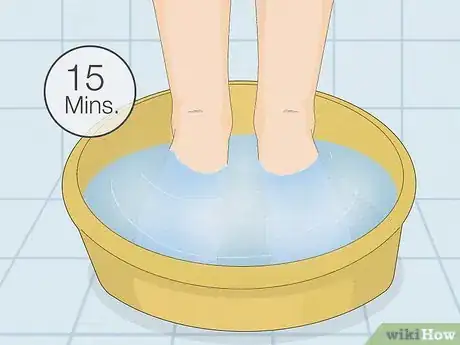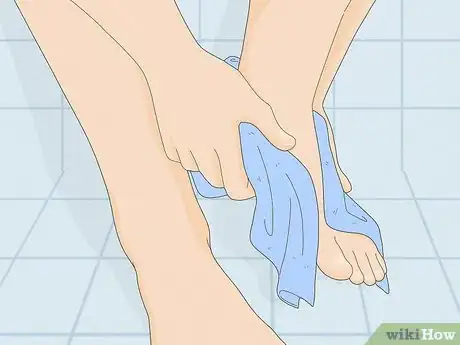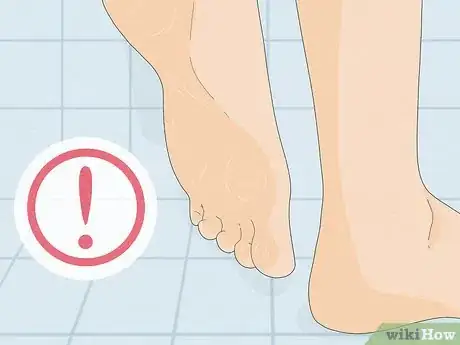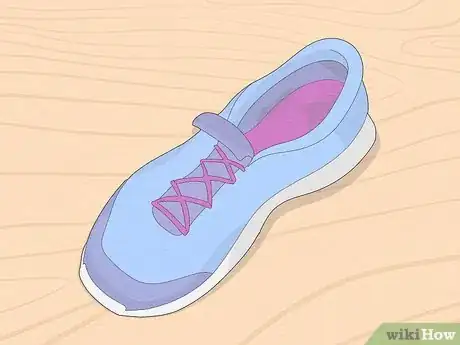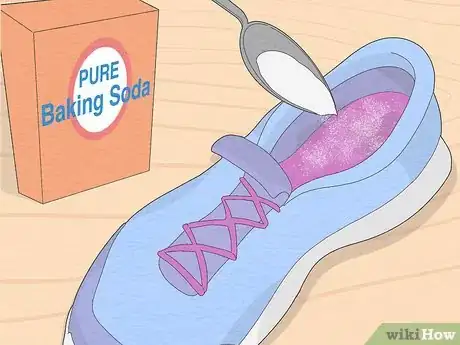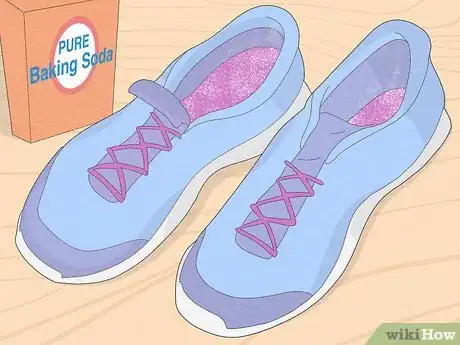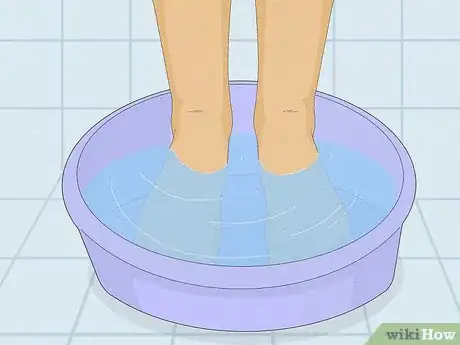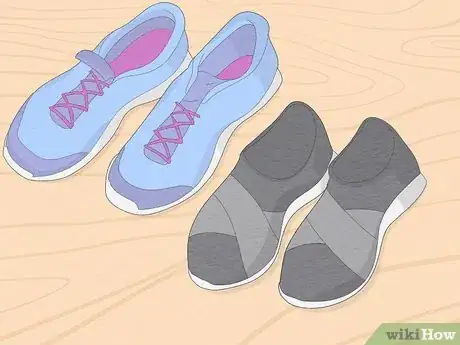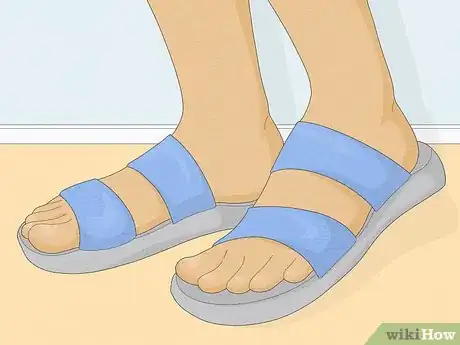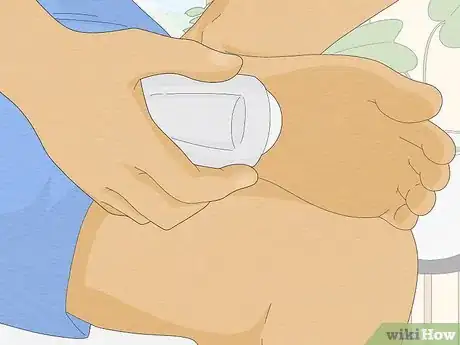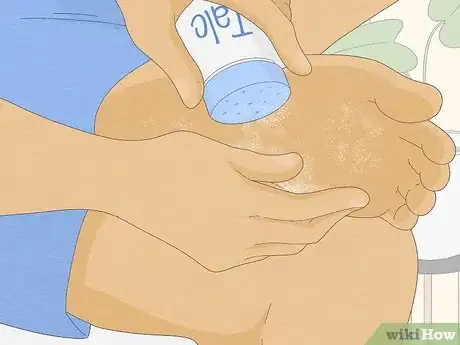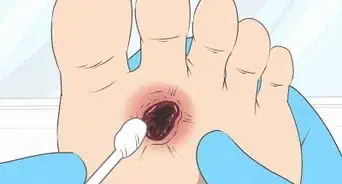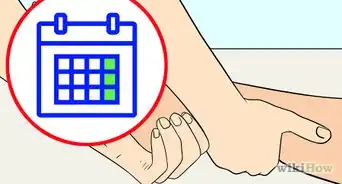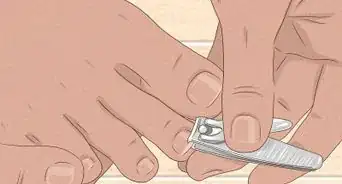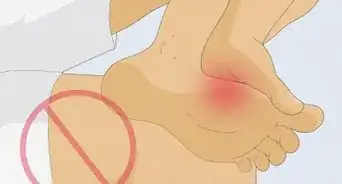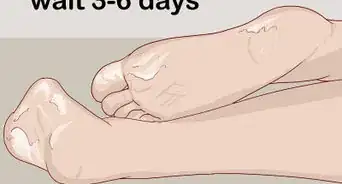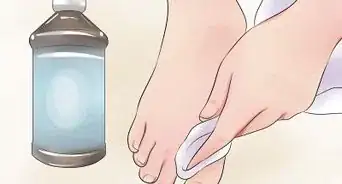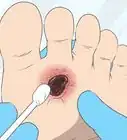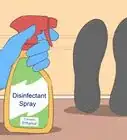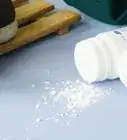This article was co-authored by Catherine Cheung, DPM. Dr. Catherine Cheung is a board certified Podiatrist based in San Francisco, California. Dr. Cheung specializes in all aspects of foot and ankle care, including complex reconstruction. Dr. Cheung is affiliated with the Brown & Toland Physicians and the Sutter Medical Network. She earned a DPM from the California College of Podiatric Medicine, completed her residency at the Encino Tarzana Medical Center, and completed a fellowship at the Kaiser Permanente San Francisco Medical Center. She is board certified by the American Board of Podiatric Surgery.
This article has been viewed 146,138 times.
Baking soda, also known as sodium bicarbonate, is noted for its ability to absorb moisture and odors and has a demonstrated ability to kill odor-causing bacteria.[1] In addition to being a must-have in your fridge, there are a few ways in which baking soda can be used to directly and indirectly combat foot odor.
Steps
Deodorizing your Feet
-
1Make a foot bath with water and baking soda. Find a bucket or tub large enough to put your feet in, and fill it with warm water. Add 1/4 cup of baking soda at a time until the bath remains cloudy, stirring after each addition.
-
2Soak your feet in the bath. Soaking them for at least 15 minutes daily will help to reduce the odor that your feet produce. For added benefit, scrub them with a washcloth towards the end of your 15-minute soak.
- The baking soda helps kill bacteria on your feet while also softening your feet to make dead skin more easily removable.[5]
Advertisement -
3
-
4Look out for signs that you're soaking too much. If you're soaking for too long each sitting, or soaking too often, you may notice extremely wrinkled or sensitive feet. Decrease the length of your soaks or the frequency if you notice anything strange.
Deodorizing Shoes
-
1Attack the shoes as a source of smell. Your shoes may be the root of the problem if you have sweaty feet. Shoes that are always damp and warm from being worn make an excellent environment for bacteria to grow.[8] Some of the bacteria and the associated scent can then easily transfer to your feet every time you wear your shoes.
-
2Put baking soda in your shoes every night after wearing them. Pour 2 tablespoons of baking soda into the heel of each shoe and shake some of the powder down to the toes. The baking soda will absorb moisture in the shoes, which will reduce the chances of growing odorous bacteria. Additionally, baking soda absorbs the already existent odors, reducing the scent left in your shoes when you put them on the next day.[9]
- Consider mixing antifungal powder in with the baking soda to absorb even more moisture.[10]
-
3Pour out the baking soda before putting your shoes on. Do not wash the shoes with water to remove the baking soda. Remember, moisture will only increase the chances of growing bacteria and, as a result, making your feet and shoes stink.[11] [12] If you are having trouble removing all of the baking soda, try using a hand towel or knocking the shoes off on a hard surface.
-
4Apply baking soda to particularly smelly shoes for a few days. If you've got an older pair of shoes, or one that has built up a particularly pungent odor from being worn when working out, you may need to let the baking soda work for longer. Leave the baking soda in these shoes for days at a time, replacing the powder every other day if possible.
Reducing and Eliminating Odor with Other Means
-
1Clean your feet. Bacteria are known to produce common compounds associated with foot odor.[13] Scrub your feet in the shower and dry them afterwards. You can also apply an antibacterial foot spray or foot powder to reduce scent producing bacteria.
- Don't forget the areas in between your toes! These areas are more likely to hold moisture and heat and, as a result, have a higher chance of containing bacteria.
- Applying hand sanitizers to your feet is another option to help kill bacteria.
-
2Soak and scrub your feet with a home remedy. A small amount (1 oz) of bleach per gallon of water is thought to help kill bacteria on your feet after a 5 to 10-minute soak. Some other common home remedies include:
- Vinegar water. For every quart of water add 1/2 cup vinegar. Soak for 15 minutes and rinse with water afterwards.
- Salt water. Add half a cup of salt for every quart of water, and soak your feet for 15 minutes. Don't rinse with water and just dry your feet after the soak.
- Aluminum acetate soak. Combine 1 packet Domeboro powder or 2 tablespoons of Burow's solution with a pint of water and soak your feet for 10 to 20 minutes. Rinse with water afterwards.
-
3Wear clean, absorbent socks. Cotton and wool socks drastically reduce the moisture absorbed by your shoes. Additionally, they are significantly easier than shoes to clean and change after each use. Washing socks between each wear is important, as it keeps smelly bacteria from growing.
- When you wash your socks, turn them inside out to ensure that all of the dead skin gets washed out.
- If you must re-wear a pair of socks prior to washing, put some baking soda in them overnight to reduce moisture and bacteria that cause bad odors.
-
4Avoid wearing the same pair of shoes on consecutive days. The extra time sitting on the shelf will allow your shoes to dry out and stop bacteria from growing. You can aid this process by removing the insoles, or drying your shoes with a specialized shoe dryer.
- For instance, you might need two pairs of athletic shoes. That way, you can switch between them, and they'll have a chance to air out after each wearing.[14]
-
5Wash your shoes. Athletic style shoes that are meant to handle water and moisture are usually fine to wash in the washing machine. If you get your shoes particularly sweaty or wet from athletic activity or outdoor adventures, washing your shoes is definitely a good option.
- Don't wash nice shoes, like dress shoes or loafers, as they are likely to degrade and fall apart.
-
6Wear open-toed shoes or sandals. Cooler feet means less sweat, which translates to less smell. Not only will the increased airflow reduce moisture around your feet, but it will also lower the temperature, leading to less favorable breeding grounds for bacteria.
- If you have to wear socks to work, try changing socks halfway through the day, and switch to open-toed shoes as soon as you get home.[15]
-
7Use a foot deodorant. Many deodorants are available for both your feet and shoes. Some common examples work by trapping odor-causing molecules and absorbing moisture from the feet, socks, and shoes.
- Baby powder is also commonly used as a foot and shoe deodorant and moisture remover.
- Don't let your feet dry and crack. While getting rid of foot odor is important, you may need to occasionally apply moisturizing lotion to prevent your skin from cracking.
-
8Apply a traditional deodorant or antiperspirant. If you use underarm antiperspirant or deodorant, grab a spare stick and apply to your feet before you go to sleep. Similar to applying on your underarms, this should reduce the moisture produced by your feet and help cover up some of the odor.
- Make sure your feet are dry before applying deodorant or antiperspirant.
-
9Use an astringent. Astringents are compounds that absorb moisture from the cells. Some good examples are mineral salts like potassium alum, witch hazel, or talcum powder. These compounds can be slightly irritating but are well-known household remedies for body odor and sweat.
-
10Remove the dead skin from your feet. There are plenty of tools, like pumice stones and foot files, that can be used to regularly remove dead skin. Though there is not a scientific consensus, it is generally believed that some common odor-causing bacteria feed on dead skin.
Expert Q&A
Did you know you can get expert answers for this article?
Unlock expert answers by supporting wikiHow
-
QuestionWhat are some safety tips for using baking soda to control foot odor?
 Catherine Cheung, DPMDr. Catherine Cheung is a board certified Podiatrist based in San Francisco, California. Dr. Cheung specializes in all aspects of foot and ankle care, including complex reconstruction. Dr. Cheung is affiliated with the Brown & Toland Physicians and the Sutter Medical Network. She earned a DPM from the California College of Podiatric Medicine, completed her residency at the Encino Tarzana Medical Center, and completed a fellowship at the Kaiser Permanente San Francisco Medical Center. She is board certified by the American Board of Podiatric Surgery.
Catherine Cheung, DPMDr. Catherine Cheung is a board certified Podiatrist based in San Francisco, California. Dr. Cheung specializes in all aspects of foot and ankle care, including complex reconstruction. Dr. Cheung is affiliated with the Brown & Toland Physicians and the Sutter Medical Network. She earned a DPM from the California College of Podiatric Medicine, completed her residency at the Encino Tarzana Medical Center, and completed a fellowship at the Kaiser Permanente San Francisco Medical Center. She is board certified by the American Board of Podiatric Surgery.
Board Certified Podiatrist
References
- ↑ http://onlinelibrary.wiley.com/doi/10.1111/j.1468-2494.2011.00649.x/abstract
- ↑ http://onlinelibrary.wiley.com/doi/10.1111/j.1600-0846.2009.00399.x/abstract
- ↑ https://onlinelibrary.wiley.com/doi/abs/10.1111/j.1365-2133.1990.tb06265.x
- ↑ http://onlinelibrary.wiley.com/doi/10.1111/j.1468-2494.2011.00649.x/abstract
- ↑ http://onlinelibrary.wiley.com/doi/10.1111/j.1468-2494.2011.00649.x/abstract
- ↑ http://onlinelibrary.wiley.com/doi/10.1111/j.1468-2494.2011.00649.x/abstract
- ↑ http://dermnetnz.org/bacterial/microorganisms.html
- ↑ http://onlinelibrary.wiley.com/doi/10.1111/j.1468-2494.2011.00649.x/abstract
- ↑ http://onlinelibrary.wiley.com/doi/10.1111/j.1468-2494.2011.00649.x/abstract
- ↑ Catherine Cheung, DPM. Podiatrist. Personal interview. 12 May 2020.
- ↑ http://onlinelibrary.wiley.com/doi/10.1111/j.1468-2494.2011.00649.x/abstract
- ↑ http://dermnetnz.org/bacterial/microorganisms.html
- ↑ http://onlinelibrary.wiley.com/doi/10.1111/j.1468-2494.2011.00649.x/abstract
- ↑ Catherine Cheung, DPM. Podiatrist. Personal interview. 12 May 2020.
- ↑ Catherine Cheung, DPM. Podiatrist. Personal interview. 12 May 2020.
About This Article
Baking soda is great for absorbing moisture and odors, so use it to control foot odor. Try making a foot bath with warm water and baking soda. Add ¼ of a cup of baking soda at a time until the bath becomes cloudy. Soak your feet in the bath for 15 minutes and repeat daily. Another way to use baking soda to control foot odor is to deodorize your shoes with it every night after wearing them. Pour 2 tablespoons of baking soda into the heel of each shoe and shake some of the powder down to the toes. Before putting your shoes back on, pour out the remaining powder. If your shoes are particularly smelly, leave the baking soda in them for a few days. To learn more ways to eliminate food odor, keep reading!

